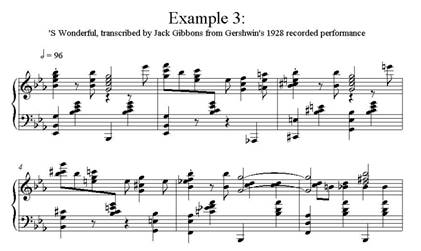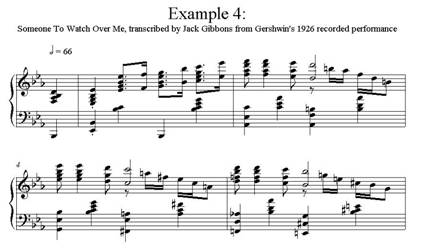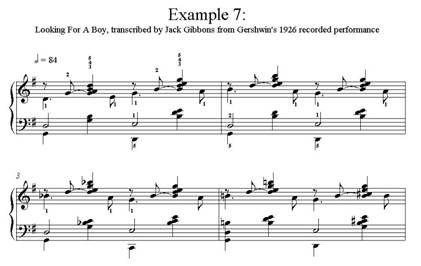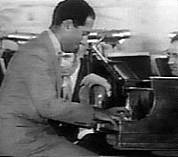|
||
|
MORE WORDS...
|
|
|
|
George Gershwin was equally at home
in a Broadway theatre and in Carnegie Hall; he seemed to revel in crossing conventional
boundaries. Central to both worlds was his love of the piano. His enthusiasm for regaling |
|
|
For a musician, George Gershwin did not have an auspicious start in life. Born in Brooklyn, New York on September 26, 1898, he grew up on Manhattan’s Lower East Side, where he was known for being a lively and mischievous child more interested in paying and fighting in the street than in anything musical. His parents Morris and Rose Gershovitz (Russian immigrants who had settled in New York in the early 1890s) weren’t particularly musical and it was not until George was 12 years old that the Gershwin household acquired a second-hand upright piano – not for George, but for his older brother Ira to take lessons. In Ira’s own words, “No sooner had the upright been lifted through the window to the front room floor than George sat down and played a popular tune of the day. I remember being particularly impressed by his left hand. I had had no idea he could play and found out – despite his roller-skating activities, the kid parties he attended, the many street games he participated in (with an occasional resultant bloody nose) – he had found time to experiment on a player piano at the home of a friend.” To Ira’s relief the threat of piano lessons vanished! It seems that George had taught himself to play by the unpromising method of fitting his fingers into the keys of the player piano as it played. With his remarkable natural talent George progressed rapidly, and in less than 3 years, at the age of 15, he abandoned school (much to the disapproval of his mother) to become a “piano-pounder” in New York’s Tin Pan Alley for $15 a week. |
||
Gershwin’s first big break came when the
singer Al Jolson agreed to record “Swanee” after hearing one of Gershwin’s
characteristic piano renditions of it at a New York party in 1919. Jolson’s recording
sold over a million copies and almost overnight George Gershwin became a household name.
Meanwhile in the concert field, Gershwin was busying himself with pieces ranging from a
string quarter movement (Lullaby) to a mini-opera (Blue Monday). It’s a common
falsehood often quoted today about Gershwin’s career that in began with success in
the popular song industry before Gershwin’s ambitions as a serious composer asserted
themselves: in reality both careers (of Gershwin the popular song composer and Gershwin
the classical composer) emerged at the same time. In fact his first big hit in New York
was not with a Broadway show, but with a concert work: the first performance of the Rhapsody in Blue in February 1924, was a tremendous
success. From then on Gershwin did not look back in either field, and as his Broadway
career blossomed with such shows as Lady Be Good
(1924), Oh Kay! (1926), Girl Crazy (1930), and Of Thee I Sing (1931), so his status in the concert
hall grew alongside with the Concerto in F
(1925), An American in Paris (1928), Second Rhapsody (1932), Cuban Overture (1932), and the Variations on I Got Rhythm (1934). Gershwin’s
crowning achievement – uniting the worlds of both the theatre and the concert hall
– was his epic opera Porgy and Bess (1935). Right to the end of his all-too-brief
life Gershwin confounded his critics by refusing to be categorized. For him a 32-bar song
was as important as a three-movement concerto (and no less demanding to compose) and he
had no time for musical labels or categorizations: “From any sound critical standpoint, labels mean nothing
at all. Good music is good music, even if you call it ‘oysters’”, he
once wrote.
In 1937
Gershwin was at the height of his powers, as a composer of both serious concert works and
immortal songs; he talking enthusiastically of plans for a string quartet (already
sketched out inside his head), a symphony, and another opera. It seems particularly tragic
that it was precisely at this time that he was suddenly and dramatically cut down; his
sudden death from a brain tumour on July 11th 1937, at the age of only 38,
shocked the world. His friend Edward G. Robinson wrote a moving epitaph: “I value above all things the memory I have of
George Gershwin. George – high-spirited, almost boyish – simple –
unaffected – loveable – and charged with the power to make all things, great and
small, absorbing and significant.”
After
George’s death, his brother Ira, now bereft of a song-writing partner, became a
guardian of his brother’s work. He was George’s greatest advocate and defender
against detractors; normally placid and easy-going, it angered him when he felt his
brother was being unfairly attacked: “Generally,
an unfavourable notice of my brother’s music doesn’t bother me too much. So
someone doesn’t like the ‘Rhapsody’ or ‘American in Paris’ or
whatever it is. So someone is entitled to his opinion. So all right. What does bother me
is when I see phrases like ‘naive orchestration’ or ‘structural
ignorance’ as though my brother were just a terribly talented fellow (which they
grant) who somehow stumbled into the concert hall... With these critics there is an utter
disregard of the facts that George from the age of 13 or 14 never let up in his studies of
so-called classical foundations and that by the time he was 30 or so could be considered a
musicologist (dreadful word) of the first degree besides being a composer. When, in 1928,
he went to see Nadia Boulanger in Paris about studying with her she turned him down on the
grounds that there was nothing she could teach him. And she wasn’t kidding.” Happily
for George Gershwin, the public has always maintained a greater sense of his genius than
any critic. Gershwin, like Chopin before him, trusted and respected the public’s
opinion, and perhaps this is one of the real reasons his music is here to stay. Despite
his all-too-short life, Gershwin made a unique and lasting impression in the world of
music. It is tempting to wonder what else he might have written had he lived longer.
During a radio interview George’s close friend Kay Swift gave the following reply to
this frequently asked question: “We’ll
never know, will we? But it would have been important.” * * * * * * * * *
It was
in the early Tin Pan Alley days that Gershwin developed much of the dazzling and
characteristic piano style that was to become the hallmark of his piano playing. Rapidly
tiring of playing the rather mundane songs he was asked to plug, the teenage Gershwin used
all his ingenuity to devise arrangements and variations to enliven them. Some examples of
these early song improvisations or variations are preserved on the early piano rolls he
cut to supplement his income. Eventually of course he became famous for embellishing his
own songs with elaborate keyboard variations, and some of these too are preserved on piano
rolls and on early electric recordings. Listening carefully to these early recordings one
can hear a serious and imaginative mind at work, the mind of the composer George Gershwin,
experimenting with his songs with a view to their potential development as musical ideas.
The melodies are frequently enhanced by the addition of playful and sometimes complex
counter-melodies above and below the main tune, while the harmonies are bolder than in the
printed sheet music, occasionally showing the influence of Gershwin’s great idol,
Debussy.
Amazingly
(considering their complexity) Gershwin never wrote down his spontaneous piano creations,
although he did publish some show-tune variations in his Song Book of 1932 (nowadays published under the
title Gershwin at the Keyboard); however,
compared with his recordings, the Song Book versions are brief, postcard-type impressions
or vignettes, with much of the complexity of his own playing eliminated. Gershwin’s
own performances, as recorded by him on 78’s in the 1920s, owe much of their rhythmic
drive to his own complex form of stride bass which he habitually used but which he
deliberately chose to exclude from his published Song Book, probably because of its
technical difficulty or perhaps because he felt it would introduce too much of the popular
piano element into what was a slightly more serious context.
For
those readers who would like to try their hand at improvising in an “authentic
Gershwin” style, it is imperative to master the left-hand stride bass before anything
else. Example 1 illustrates a typical left had stride as used by Gershwin in the key of E
flat. Almost every bar begins with a tenth chord: if this is too much of a stretch for a
small hand it can be rolled upwards, as Gershwin frequently did (play the bottom note
ahead of the beat so that the top note lands on the beat). It is a natural movement since
the hand is in any case about to move in the same direction up to the middle of the
keyboard for the second chord. It is very important that little or no pedal is used when
playing this pattern. As Gershwin himself wrote of this style of music: “The rhythms
of American popular music… should be made to snap, and at times cackle. The more
sharply the music is played the more effective it sounds.” |
||
 |
||
| Once mastered, this left-hand pattern can be adapted to suit any harmony. Gershwin might also vary the left hand with small inner parts (as in Example 2) which are often developed into full-scale counter-melodies, requiring great independence of the fingers. | ||
 |
||
|
Above this left-hand stride Gershwin
usually played the melody in thick three- and four-note chords spanning an octave, as in
Example 3, which is taken from my transcription of his 1928 recording of “’S
Wonderful”. Notice the delightful syncopation (shared between the hands) in the break
in the melodic phrase in the 2nd and 4th bars. |
||
 |
||
| Example 4, taken from my transcription of Gershwin’s 1926 recording of “Someone To Watch Over Me”, again shows how Gershwin typically fills out melody and harmony in his live keyboard performances. | ||
 |
||
| The written rhythm in the above examples are notated as in the original published songs although the actual rhythms as played by Gershwin in his own recordings are slightly different: the dotted rhythms in Example 4 are played more in the manner of a triplet rhythm, while the ‘straight’ quaver figures in Example 3 are very slightly ‘swung’. However a few words of advice should be given here about ‘swinging the beat’ in Gershwin: contrary to some present-day interpretations, Gershwin’s swinging of the beat (jazzing up the rhythm) was very restrained and very subtle. If anything, in playing a sequence of regular quavers Gershwin’s rhythm is more straight than swung (Example 5): | ||
 |
||
| compared with an exaggerated dotted effect that is unfortunately frequently heard in Gershwin performances today (Example 6): | ||
 |
||
Gershwin’s exploitation of
all the complexities of rhythm is a study in itself, and too subtle to notate accurately.
It is well worth paying careful attention to his own recordings, particularly the live 78s
(piano-rolls can easily be tampered with and are thus less reliable). Another aspect of
Gershwin’s performance that defies written analysis is the way he conveys
unrestrained enthusiasm by appearing to almost get ahead of himself as he plays. In
reality, by playing a metronome against Gershwin’s recorded performances it’s
possible to see that he isn’t rushing the rhythm at all, but keeping quite a strict
tempo; it’s merely a very skillful illusion created by almost imperceptibly
anticipating the beat, creating a wonderfully eager (but totally controlled) feeling of
almost falling forwards that’s captivating to listen to. To a classical pianist
brought up under the strict regime of holding back the rhythm (sometimes referred to as
‘rhythmic poise’) this style can seem a little unnerving to grasp. As always any
attempt at copying should be monitored carefully: Gershwin’s rhythmic idiosyncracies
(swinging the beat, anticipating the beat, etc.) are extremely subtle and should never be
exaggerated into parodies of the original when imitated. For further guidance see the CD
list of Gershwin’s recordings at the end of this article.
Gershwin
employed any number of often complex and tricky pianistic devices in his improvisations to
enable him to embellish and vary his musical ideas as he wanted. Frequently he expects his
hands to be ‘multi-tasked’, different parts of the same hand playing different
rhythms or melodies simultaneously. One device he was fond of using was the taking of the
theme with his right hand thumb, using the remaining fingers of the right hand to play
extra counter-melodies or accompanying figures. What is particularly remarkable in his
recordings is the subtlety with which he shapes the melody with just the thumb alone.
Example 7 is a typical, taken from my transcription of his 1926 recording of “Looking
For A Boy”: |
||
 |
||
The above examples only give the
briefest hint of the inventiveness of Gershwin’s own piano style. Behind all
Gershwin’s spontaneous piano creations is a highly organised and purposeful method;
what might to a casual listener on a first hearing sound like a random selection of
unrelated chords on closer examination turns out to be nothing of the sort: harmonies are
carefully chosen, even down to the doubling or not of crucial harmony notes such as the
third, and behind everything is an intelligent mind, the mind of the genius that was
George Gershwin. And remember, before the appearance of brief extracts in his 1932 Song Book, none of these improvisations were
written down: all these minute details were instead firmly locked inside Gershwin’s
head, and indeed appeared to evolve from performance to performance.
Above
all, to master Gershwin’s original style the aspiring pianist must endeavour to
capture that sense of fun and ingenuousness that was such a hallmark of Gershwin’s
piano playing. As Rouben Mamoulian (director of the original production of Porgy and Bess)
once wrote: “George loved playing the piano for
people and would do so at the slightest provocation… I am sure that most of his
friends, in thinking of George at this best, think of George at the piano. I’ve heard
many pianists and composers play for informal gatherings, but I know of no one who did it
with such genuine delight and verve. George at the piano was George happy.” The best examples of Gershwin’s own piano playing can be heard on the following two recordings:
PEARL Gershwin Plays Gershwin (2 CD set): Includes all
Gershwin’s recordings released commercially in his lifetime. GEMM CDS 9483
MUSICMASTERS
(distributor BMG) Gershwin Performs Gershwin,
a remarkable CD put together by the distinguished Gershwin biographer Edward Jablonski and
featuring the composer’s own rehearsal recordings of his Second Rhapsody and Porgy and Bess (extracts), and recordings of
Gershwin’s radio broadcasts in which his spoken voice can be heard introducing the
music items in his own inimitable style. 5062-2-C.
These notes ©
2002 Jack Gibbons |
||
|
Jack
Gibbons' own transcriptions and reconstructions of Gershwin’s original improvisations
and concert works are available on an award-winning 4-CD series (arranged chronologically)
entitled The Authentic George Gershwin (on ASV: WHL 2074, WHL 2077, WHL 2082, WHL
2110). Click on the image to visit the recordings page to see more details and find links to Amazon.com where the CDs can be purchased. |
 |
|





